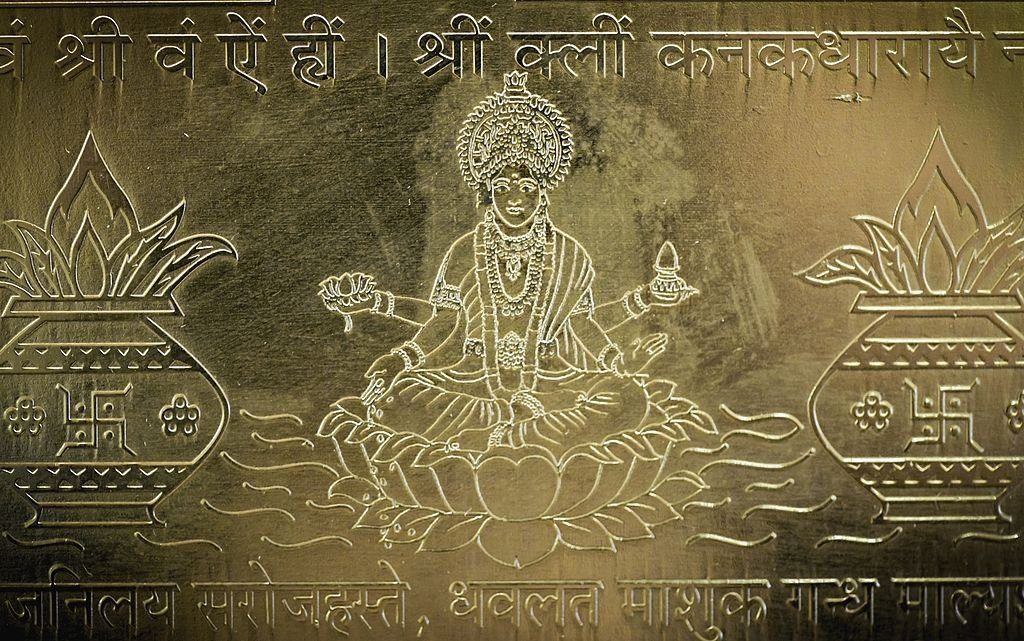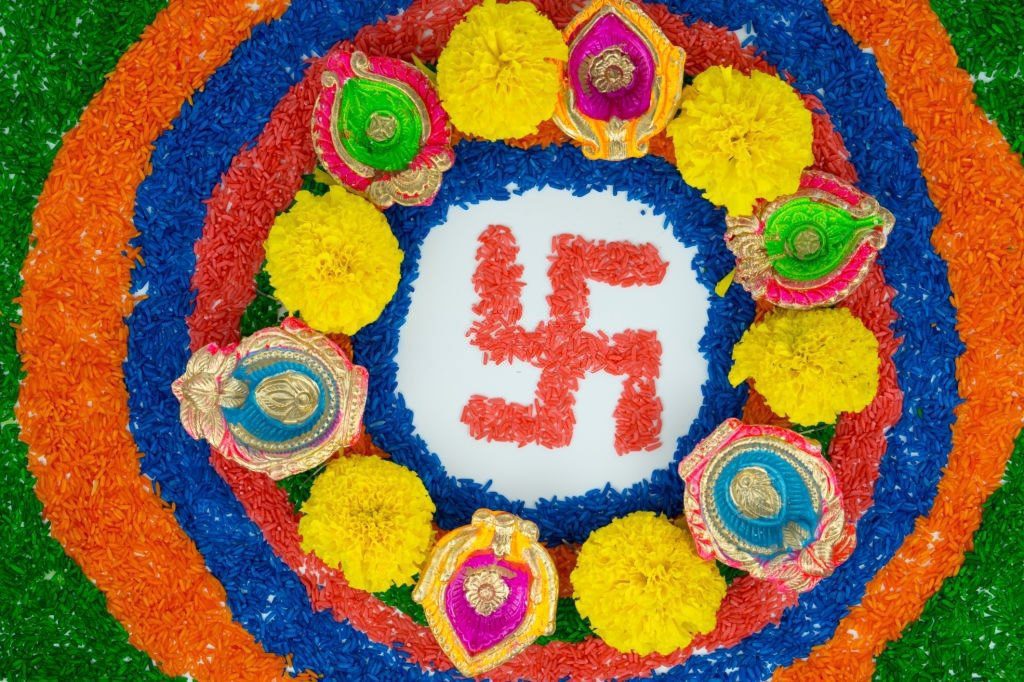Between 3000 and 4000 years ago a new wave of migrants came into India from central Asia. Some of them moved into the south in the last millennium BC. They brought their Vedic rituals and their worship of Agni, the god of fire, but over time, the gods and rituals of the indigenous peoples were assimilated, and this was the synthesis out of which today’s Indian religions emerged.
They called themselves ‘Aryans’ (the Sanskrit word for ‘noble ones’), a term much abused in recent times by Nazis and other racial fundamentalists.
Tracking the origin or Swastika Symbol

Many people in India believe the symbol of Swastika to be indigenous to their culture, however, the symbol has a long recorded history and has been found across the globe.
The earliest known use of the Swastika symbol—an equilateral cross with arms bent to the right at 90° angles—was discovered in Ukraine in 1908 carved on a 15,000-year-old ivory figurine of a bird made from a mammoth tusk. Yes, the symbol appears to be one of the oldest symbols our ancestors seem to have adopted which carried a meaning.
The ancient engraving is hypothesized to have been used for fertility and health purposes, a pattern similar to one that is found naturally occurring on the mammoth—an animal that has been regarded as a symbol of fertility during ancient times.
It is not entirely clear how the first Swastika symbol design emerged. Some speculate that it may have simply been an elegant, easy-to-create geometric shape, although its inspiration possibly came from a comet in the night sky.

In Eastern Europe, single swastikas were carved by the Vinca culture during the Neolithic period, some 7,000 years ago, before they became widespread from the Bronze Age. The swastika symbolized the Sun to the Illyrians — became a common sight on Mesopotamian coins.
It also appeared on vases and clothing in Greece — formed mosaic motifs in Rome, and stands in as a stylized cross in Celtic design. There are 27 swastikas on the Iron Age Battersea Shield, found in London in 1857, but the symbol had been in Britain long before that as the so-called Swastika Stone on Ilkley Moor, Yorkshire, from c2,000 BC, shows. This carving resembles the swastika’s shape, although with more curved arms and added spots.
From the symbol of positivity to the Nazi symbol

Since its origin in ancient times and throughout history, the symbol has always represented the positivity and encouragement of life. The origin of the word Swastika is from Sanskrit Svastika, which means “conducive to well-being.”
It has been widely used by almost all cultures around the world and still being used in the Indian subcontinent for many different purposes throughout history — as a symbol in Hinduism, Buddhism, and Jainism — as a stylized cross in Christianity; in ancient Asiatic culture as a pattern in art — in Greek currency– in Medieval, Renaissance, and Baroque architecture– and on Iron Age artifacts.
While the symbol has a long history of having a positive intention, it was forever tainted by its use in one cultural context– Nazi Germany.
Nazi use of Swastika symbol
In 1920 Adolf Hitler first adopted the Swastika as a German national symbol and as the central element in the party flag of the National Socialist Party, or the Nazi Party, which rose to power in Germany the following decade.
By 1945, the symbol became the representation of World War II, military brutality, fascism, and genocide—spurred by Nazi Germany’s attempted totalitarian conquest of Europe. While for Hindus, Buddhists, and Jains in Indian Subcontinent it always remained the revered symbol of good fortune.
Miles Russell is a British archaeologist best known for his work and publications on the prehistoric and Roman periods. He asserts that the transition from auspicious svastika to despised swastika began in the late 19th century.
The icon was chosen by the Nazi party to represent its goal of racial purification in Europe. Hitler and his Nazi Party believed that a line of pure Germanic ancestry originating in the Aryan race—a grouping used to describe Indo-European, Germanic, and Nordic peoples—was superior and that other, less-superior races should be ousted from Europe.
Ancient Indian artifacts once owned by Aryan nomads were found to frequently feature the swastika, and the symbol was co-opted from its ambiguous historical context in the region to exert the dominance of the so-called Aryan heritage.
Since World War II, the swastika has become stigmatized as a symbol of hatred and racial bias. It is used frequently by white-supremacy groups and modern iterations of the Nazi Party. Along with other symbolism employed by the party, the use of the icon has been outlawed in Germany in many parts of Europe.
How Swastika Became a symbol of Nazi Germany
Heinrich Schliemann, a wealthy businessman from Germany had grown obsessed with finding Troy, the lost city of Greek mythology, and believed the epics of Homer would show him the way. In 1868 he ventured out with his copy of The Iliad to search the Mediterranean.
Several years passed, the findings proved frustrating and he was very close to giving up, but a British amateur archaeologist named Frank Calvert made a suggestion — Schliemann should dig at the mysterious mound of Hisarlik on the Aegean coast of Turkey.
There, during the 1870s, Schliemann unearthed layers of civilizations dating back thousands of years and declared the oldest to be Troy. The city of legend had been found – although it turned out to be a different layer than the one Schliemann thought – as well as a cache of jewelry, bronze, silver, and gold.
It was more than he had ever hoped to find. Yet in the ancient ruins, he made another fateful discovery– some 1,800 depictions of a symbol that resembled a cross with bent arms– The Swastika!
News of Schliemann’s sensational excavations spread far and wide, quickly followed by the discovery of Swastika, which became a universal sign, visible everywhere in Europe and North America.
Swastikas would appear in advertising, adorning buildings as architectural motifs, and worn on badges or medallions. Sports teams, from ice hockey to basketball, even named themselves the Swastikas, so closely was the symbol associated with luck and success.
At the same time, however, the swastika’s long history saw it become a favorite of German nationalists, who subscribed to a manipulated theory that they are the descendant of an ancient ‘Master Race’ known as the Aryans. This somehow fostered the sense of superiority from others who don’t belong to the so-called master race.
This belief continued into the 20th century, growing more destructive until it appealed to Adolf Hitler, the leader of the burgeoning Nazi Party, He adopted the swastika as a symbol of the movement in 1920.
Then, as the red flags emblazoned with a harsh black swastika on a white circle of the Third Reich were marched over Europe and the world went to war, it now came to stand for hatred, fear, racial intolerance, and genocide. A manifestation of evil, even for some.
Why did Hitler choose the swastika?
When Adolf Hitler began his rise to power and looked for a symbol to represent his movement, the Nazi Party, and a strong future for Germany, the swastika became the clear choice at that time.
Hitler knew the power of optics and knew it would give the Nazi ideals a historic foundation. He could not adequately reconcile his view of Germany’s Christian history with the religion’s historical Jewish connections – essentially, that Christ was himself Jewish – so the idea that Germans descended from a white master race with a tried and tested symbol had great appeal.
The Swastika, or hakenkreuz (hooked cross), became the emblem of the Nazi Party in 1920; Hitler himself took personal credit for designing the flag. It used the red, white and black of the old German imperial flag – a cunning move to link Germany’s past with its future – but attributed new meanings to them.
“In red we see the social idea of the movement, in white the nationalistic idea, in the swastika the mission of the struggle for the victory of the Aryan man,” wrote Hitler in his 1925 autobiographical manifesto, Mein Kampf.
The new design became the national flag on 15 September 1935 during the mass annual rally at Nuremberg. On the same day, two race laws were passed prohibiting marriages between Germans and Jews and declaring that only those of German blood could be citizens of the Reich. And so the act of cultural, religious, and social theft that was the appropriation of the swastika was complete.
It ensured that the Nazi flag would be associated with evil – under which a brutal war raged, atrocities committed and some six million Jews murdered in the Holocaust.
In the aftermath of World War II, publicly displaying the swastika was banned in Germany, where it remains illegal. Yet while reviled in the Western world, it continues to be an influential symbol with far-right and white-supremacist groups.
In the US, where its use is permitted, incidents involving swastika flags and graffiti have increased in recent years, most infamously when neo-Nazis marched in Charlottesville, Virginia, in 2017.
How is Swastika seen today

The Aryans had adopted the Swastik as a symbol for the good of humanity. The Hindus added some more arms to the Swastika to represent happiness in married life and worldly successes. Thus, the Swastik became a combined symbol for all Gods, and the traders and business community adopted it for all occasions.
The Swastika always continued as a symbol of worship for Hindus, Buddhists, and Jains. It can be seen apparently everywhere in parts of the Indian subcontinent – from temple entrances to the front of taxis – and plays an important role in ceremonies and festivals. During Diwali – the Hindu festival of lights – the swastika is drawn with colored sand, or rangoli, and depicted with lanterns to celebrate the victory of light over darkness and good over evil.
In 2007, when German politicians attempted to introduce a swastika ban across the European Union, Hindus in India and across the world strongly opposed the measure on religious grounds.
The two different representations of Swastika, for Hindus and the rest of the western world, do raise the question of whether the symbol – which for so long has been a force for good – can be reclaimed from its association with Hitler and the neo-Nazis who still display it.
Some believe, reclaiming the symbol will essentially mark the final defeat of the Third Reich and the hatred it stood for? Or is that impossible? The 20th-century corruption of the Swastika came to represent so much of the horrors of Nazism that it should never be forgotten.
The answer, although not a very clear one because the use of symbolism for white-supremacist and Neo-Nazi has not subsided and may even be increasing. Maybe that there will always be two completely conflicting ideas of the swastika, both of which are part of our history, present, and future — one representing the worst of humanity has to offer and the other symbolizing a piece of good luck for us all.



